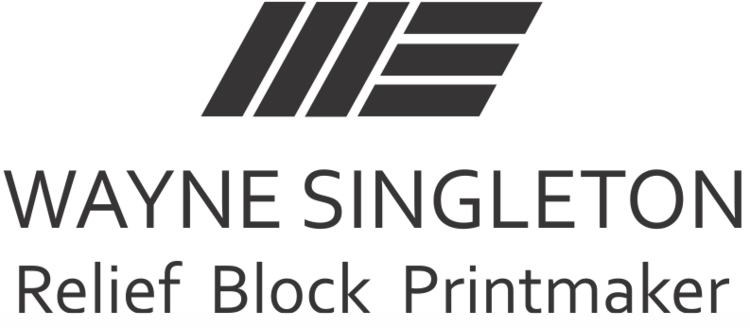All that you ever wanted to know about limited edition Relief Block prints
Wayne Singleton produces limited edition original prints. Wayne’s prints are individually produced by hand, from a block (the printing plate) which he cuts by hand from a composition drawn by him. Each of these prints are then individually hand coloured.
Wayne also has limited edition Giclee (high quality fine art reproductions) produced from some of his limited edition original prints.
An original print is an identifiable original because there are subtle variations between each print in the edition; like brothers or sisters. All of the Giclee prints are identical, printed on high end printers from very high resolution photographs by Art House Reproductions in Brisbane, Australia. Both the original prints and the Giclee prints have edition numbers on them. The original hand-made prints are signed by hand in pencil, the Giclee prints may have Wayne’s digital signature in the bottom right hand corner. Follow this link to learn more www.buyartnow.com.au/wayne-singleton
Why are they called Relief Block prints?
The way ink is pulled from a block is used to describe a printing process.
For example, a print which pulls ink from the surface of a block is called a relief print, whereas a print which pulls ink from below the surface of a block is called an intaglio print, (commonly called an etching).
Relief block prints are sometimes called woodcuts or linocuts, referring to common materials used to make the blocks.
What do the numbers mean?
The number of prints pulled (printed) from a block is called an edition. The Artist decides upon the size of the edition of prints. The edition number is found below the print in the bottom left-hand corner.
The number is expressed as a fraction, for example 3/40. The bottom number indicates that the total number of prints in the edition is forty. The top number records the print as being number three in the edition.
Sometimes the letters A/P appear in place of an edition number. It is part of the history of printmaking, traditionally these prints (Artist Proofs) were the first pulled from a block by a master printer for the Artist to check and approve before the editioning took place. Now A/P’s tend to represent a small number of prints that stand outside the edition - they are prints that an Artist has reserved for him/herself.
These invariably end up on the secondary market and there are collectors who only buy Artist Proofs or A/P’s.
How does it all happen?
Images are drawn or transferred in reverse onto a block. The block is then cut by hand using a variety of tools. Wayne’s large blocks can take up to several weeks to cut.
When a block has been cut, most print-makers will then use a hand-operated press to transfer the image from the block onto the paper.
The paper on which Wayne prints varies from edition to edition, but is mainly Arches Rives BFK. It is pH neutral and 100% cotton. This limits to risk of a print foxing (going funny colours and growing things) as it ages.
Once Wayne has printed an image, the print is cured in a drying rack then booked (stacked flat under pressure) to enable the ink to cure a little more and to allow the paper (and the printer) to relax back into shape.
Why hand colouring?
This tradition goes back to the earliest days of western print-making. There are accounts of some Crusaders being given hand coloured relief block prints (of Saints presumably) before heading off to the Holy Land.
Wayne uses Windsor and Newton watercolour, gouache (opaque watercolour) or F&W acrylic ink. These media have a high permanency rating.
Each print is coloured by hand and once coloured the finished print is numbered, named and signed.
What does the printmakers' mark mean?
In Wayne’s prints you will see a stylised WS logo in either the bottom left or right corner.
It also appears on every page of this website. It is part of western printmaking tradition for printmakers to cut their ‘mark’ into their blocks - for example, Google the medieval printmaker Albrecht Durer.
Wayne’s printmaker’s mark is inspired by the old ACI Fibre Packages logo. ACI was the company where he trained as a Stereo (Relief Block) Cutter as a young man.
His registered printmaker’s trademark has appeared in all of his prints for more than 25 years. It reminds Wayne of the debt of gratitude that he owes the craftsmen who trained him.
Wayne tries to honour that debt by being the best printmaker that he can and by keeping the block maker craft skills alive.
The logo is usually the last part of the block that Wayne cuts and he uses the same type of knife to cut it as he used to cut commercial stereos in industry.
